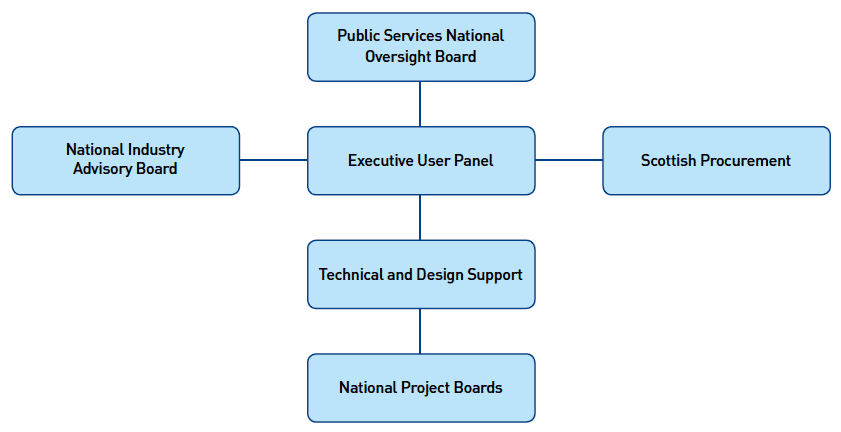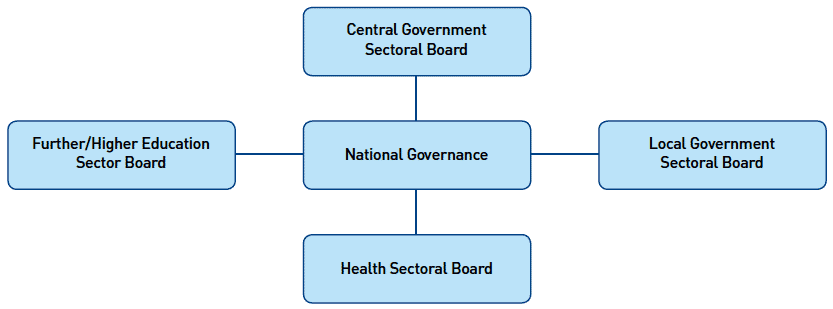Review of ICT Infrastructure in the Public Sector in Scotland
Report by John McClelland CBE on his review of ICT infrastructure in the public sector in Scotland.
14 Recommendations
| ICT Strategy |
|
|---|---|
| 14.1.1 |
A new five-year ICT strategy should be developed for each separate part of the public sector. These should plan to move the model from local self-sufficiency to sharing within each sector, i.e. local authorities, health service, universities and colleges, wider Scottish Government, police and fire. |
| 14.1.2 |
An overarching national public sector IT strategy should be developed which addresses national imperatives and pan public sector opportunities and needs and incorporates the sector strategies recommended above. |
| 14.1.3 |
These strategies should adopt the proposed strategic principles outlined at section 12: Proposed Strategic Principles . |
Figure 1: illustration of proposed national governance structure described at 14.2.1

| Oversight and Governance |
|
|---|---|
| 14.2.1 |
There should be a national oversight and " ICT futures" board chaired by the Cabinet Secretary. This board should exercise leadership, responsibility for the strategy and the appropriate authority to deliver it. In addition it should have specialised responsibility in areas of ICT that have national dimensions such as broadband, design standards and citizen focused needs that demand seamless cross-sector capability without boundaries. |
| 14.2.2 |
Each major part of the public sector should also have a group or board responsible for developing, overseeing and implementing the ICT strategy for its own sector. As with the national activity these sector boards should have responsibility and authority. These structures will require technical support and should lean on existing mechanisms and groups. They should also have a user panel which oversees and supports sector procurement and commissioning and also sponsor and make use of benchmarking exercises for their own sectors along the lines of those orchestrated by SOCITM for local authorities. |
| 14.2.3 |
The "authority" referred to above should be adopted by the Scottish Government by requiring mandatory participation and compliance by all Scottish Government departments, agencies, NDPBs and the health service. Other sectors such as local authorities and further and higher education should arrange to have a system of delegated central authority within their own sectors and also formally sign up to participating in the National Board and its Committees and to upholding their decisions and actions. |
Figure 2: illustration of proposed sectoral governance structure described at 14.2.3.

| Transformation |
|
|---|---|
| 14.3.1 |
Supported by these new boards the public sector in Scotland should embark upon a major programme to transform how it progresses ICT at a local, regional, sub-sector and national level towards the vision described in this report and in line with the strategies recommended at section 12. Proposed Strategic Principles. This initiative should drive a paradigm shift in how ICT is adopted, deployed and services delivered and should include the monitoring and provision of guidance on the national or sectoral optimisation of investments in ICT. The overall leadership, oversight and facilitation for this transformation programme should be provided at a national level. |
| 14.3.2 |
The programme should also lean heavily on existing initiatives, infrastructures and organisations and technical forums should support it in vital areas of standards, security and protocols to facilitate cross sub-sector sharing at a regional level and/or in specific linked customer facing areas such as social and health partnerships. Given the need to build upon exemplars and existing sunk investments the transition will have a strong theme of convergence and connecting infrastructures rather than building everything new. |
| High Level ICT Operating Framework |
|
|---|---|
| A high level ICT architecture should be developed to act as a blueprint for moving from the status quo towards the ultimate vision. The fragmented public sector landscape, although not an environment where sharing is prevalent, is partially populated with examples of excellence from individual organisations which have also in some cases installed the same common systems capability as others. Sometimes these common systems are deployed in a single shared instance but in most cases not. This has evolved into a complex landscape and one where a detailed plan is required to build on these points of excellence and partial sharing and extend them to create a network of common applications which are shared through being centrally hosted in a minimum number of "instances" for each sub-sector. The blueprint should also focus on online access and interaction and the use of ICT to improve the quality and effectiveness of services delivered. The following are the proposed elements of this framework. |
|
| 14.4.1 |
There should be differentiation horizontally across by sector and vertically down over the distinct layers of ICT infrastructure. Each part of the public sector should agree on where services are best provided from. Some will come from within individual organisations, some will be provided at a sector level or regionally within a sector. Others could be provided regionally across sectors and finally there will be services provided nationally. |
| 14.4.2 |
Broadband should be a national service as should services that are closely interwoven between the various sectors and the Scottish Government. |
| 14.4.3 |
Sectors should operate their own minimum number of data centre services either at a central level or regionally or a hybrid of both. Cross-sector sharing may be appropriate in some parts of the country and also of applications that support the need for seamless citizen related services described earlier in this review. This approach should incorporate aggressive pursuit of internal and external "Cloud Computing" concepts. Sustainability should be a key consideration. |
| 14.4.4 |
Chief Information Officer functions, information management and unique services should be delivered by local organisations. |
| 14.4.5 |
Standards, protocols and overall technical design authority should be led nationally but be a cross public sector participative activity. |
| 14.4.6 |
At all levels outsourcing and industry partnerships should be evaluated to take advantage of industry experience, rely on their capital investments and optimise cost. |
| 14.4.7 |
Local loop unbundling should be evaluated and where appropriate adopted on a cross-sector regional basis. |
| 14.4.8 |
Extension of the use of other new technologies and concepts should be evaluated at a sector level or where more appropriate nationally. |
| 14.4.9 |
Existing applications and physical infrastructure will require to be re-used and built upon. Where a concentrated number of common applications or capabilities prevail then an approach of connecting the "islands of excellence" should be pursued so that there is a minimum number of hosting and support activities within each sector and minimal if any local development. Migration plans should be firm but recognise existing contracts and investment so that transition costs are minimised. |
| 14.4.10 |
At the national level there should be a formal project dedicated to citizen priorities including seamless cross sector integration of service and data and in particular the needs of the elderly, sick and other vulnerable groups. It should also include other areas such as transport access and data management. |
| Procurement and the ICT Industry |
|
|---|---|
| The public sector's unstructured approach to the ICT industry and its suppliers needs radical change. This change should embrace a more integrated approach to procurement, specific structures and arrangements to deal specially with the largest suppliers and also a special focus on SMEs which are not only vital to our economy but also need channels to offer innovation and new technology into the supply chain. These new arrangements should allow the public sector to be formally advised and supported by the industry's experience and skill and even where appropriate to form partnerships in which the industry through outsourcing and its own investment can assist the public sector with different business models during these times of financial constraint. |
|
| 14.5.1 |
Given the strategic, technological and structural nature of the ICT industry there should be executive and technical professional leadership of the "go to market" approach. This mode should be supported by the established centres of procurement expertise. This leadership and co-ordination should be established sector by sector and also nationally and be an integral part of the oversight and governance model already recommended. |
| 14.5.2 |
The aggregation of purchased value and management of awards and tenders is a critical success factor in achieving value and delivering progress in ICT adoption and delivery. The presumption should be that major ICT contracts are awarded for a complete sector. Important exceptions would be where national priorities or opportunities show advantages. Broadband, telephony, some software licences and some types of hardware are examples in that category. These procurement activities should be overseen and supported by executive user panels. |
| 14.5.3 |
In an industry with a combination of SMEs, companies offering specialised products and services and also a number of very large vertically integrated general providers it is vital that tenders and contracts are carefully formulated. Contracts should also be"future-proof" and where there are elements of bundling there should be complete transparency for each type of service or product and procurement should incorporate commissioning and contract management. Also special attention is required to deal with the issue of ensuring SMEs have appropriate access to the public sector and in particular the opportunity to offer innovative solutions and when contracts are awarded to large suppliers they should be encouraged to take advantage of the services and products offered by SMEs. |
| 14.5.4 |
The activity of procurement is incomplete without being extended to include both the commissioning of ICT and ongoing contract management. A special focus on this should be developed sector by sector so that staff can be trained and critical resources concentrated and shared. |
| 14.5.5 |
The ICT industry is a vital cog in the machinery of the public sector and one on which there is a crucial dependency. Engagement with the industry is important and at present is far from optimal. The recommended governance mechanisms should provide a focal point for formal and informal partnership style engagement with the industry. And at a national level there should be a formal Industry Advisory Council. The Council must include SME presence. |
| Broadband |
|
|---|---|
| A new and unique plan is required to address the issues and opportunities associated with large scale broadband infrastructure within Scotland where despite prior and existing initiatives there is much room for further development. This plan should address not only cost but also the need for improved performance in terms of capacity and speed. Progress in this key area is mandatory not only for the public sector but also to ensure that there is spin-off of this capability for citizens and businesses in support of economic growth. In generating this plan current UK government initiatives should be taken into account. |
|
| 14.6.1 |
The few large and many other multiple small contracts should be aggregated to build a single Scottish Public Sector Network that adopts the standards and protocols of the UKPSN. |
| 14.6.2 |
The combined spend should be leveraged to gain cost and performance advantages for the public sector. Also it should seek availability advantages for the private sector and citizens in remote and rural areas. The contract should be a long-term arrangement and should take account of all existing initiatives and investments. |
| 14.6.3 |
This network should be used by every public sector body and university and college in Scotland. |
| 14.6.4 |
The technology of "local loop unbundling" should be evaluated and where appropriate adopted regionally. |
Contact
Email: ceu@gov.scot
There is a problem
Thanks for your feedback